Learn how to make Pine Tar Liquid Soap, and transform pine tar along with natural oils into a body wash that’s great for supporting healthy skin.
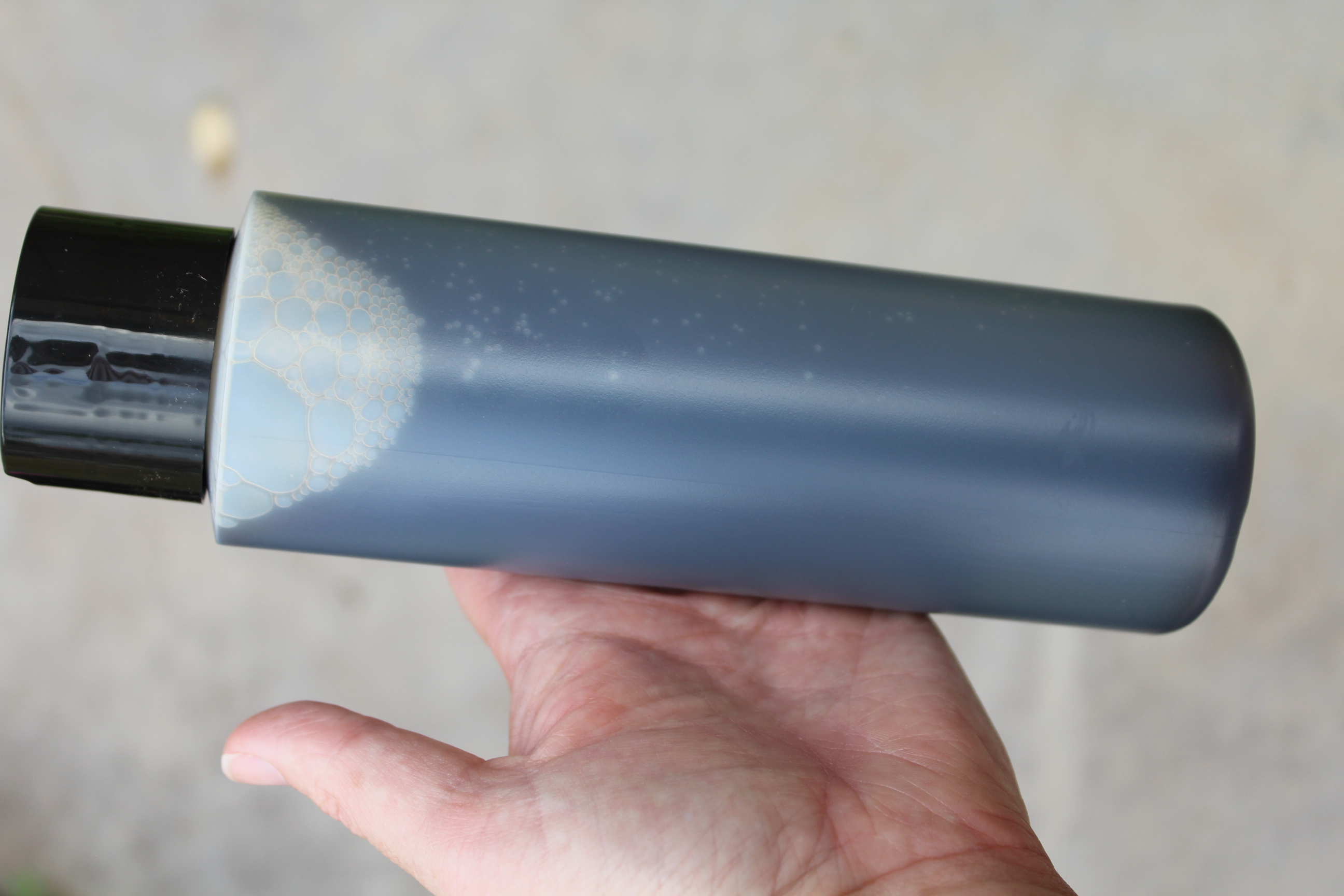
Pine Tar Soap is great for supporting healthy skin that struggles with eczema, psoriasis, dryness and other minor skin irritations. Just as Pine Tar is great incorporated into regular bar soap, it is also just as good for your skin when used as a body wash as well.
One of the biggest reasons I love using pine tar in body wash is because of the wash factor. If you have ever used pine tar soap, you’ll know that the soap can leave brown soap residue in the shower/bath. Body wash eliminates this. It keeps your shower clean of the brown pine tar soap gunk that will inevitably appear.
Not to mention, body wash is super easy to use and have available. Not only can you use it as a regular body wash, you can add to a foaming pump bottle and lengthen the life of the soap.
This pine tar soap recipe will help you create this fabulous soap at home. It’s not a difficult soap to make, but the smoky smell of the pine tar has a strong aroma and will almost remind you of an outdoor campfire. The scent makes the soap seem like more of a men’s soap, but it can be used by both men and women alike.
PINE TAR LIQUID SOAP RECIPE
Please use a scale to weigh the ingredients and ensure they are accurate.
Liquid soap is definitely one of those things that seems incredibly complicated, and some sites/tutorials really do make it that way. But this soap recipe is pretty low key and results in a beautiful soap with a combination of four different oils.
Ingredients required:
- 6.25 oz coconut oil
- 12.5 oz olive oil
- 2.5 oz castor oil
- 3.75 oz pine tar
- 4.52 oz potassium hydroxide (KoH) – 3% superfat
- 9.5 oz distilled water
FOR DILUTION PHASE:
- distilled water
PREPARATION:
Liquid soap uses a different kind of lye than bar soap. You’ll need to have Potassium Hydroxide for liquid soap (also known as Potash). You can source this from your local soap store or, pick up from Essential Depot on Amazon.
Pine Tar liquid soap is not difficult to make but it is time consuming. You’ll want to make it on a day that you can be home to watch the crock pot and give it your undivided attention.
STEP 1: MEASURE LYE AND WATER
Measure out your potassium hydroxide and distilled water in two separate, heat proof containers. Wearing gloves and goggles, add the potassium hydroxide to the water slowly, stirring to dissolve well.

STEP 2: WEIGH YOUR OILS
Weigh out the oils and add to the slow cooker. Turn the heat on low and add the water and lye solution to the slow cooker. Stir the lye with the oils for 4-5 minutes until combined. Once combined, pour in the pine tar. The mixture will immediately thicken and darken… and will be heavy to stir.
STEP 3: BLEND YOUR OILS
Using your immersion blender, blend off and on until the soap reaches trace. Try to avoid running the immersion blender continually or the motor will burn out. Instead, run for 15-20 seconds, then break for 30.
At trace, the soap will be slightly foamy on top, but be starting to thicken up.
STEP 4: COOK THE LIQUID SOAP
Over the next 3-4 hours, cook the soap in the crock pot using low heat with the lid on. Your final cook time will vary depending on your slow cooker.
Every 20-30 minutes, remove the lid of the slow cooker and check the soap progress. Stir with a spoon or heat safe spatula. Over that few hours, the soap will turn even darker than this dark brown color, then start to gel in certain areas. I might become cloudy and separate somewhat… this is all a normal part of the process. Just use your spoon and stir everything as best as you can to get it to come back together, then continue to cook.
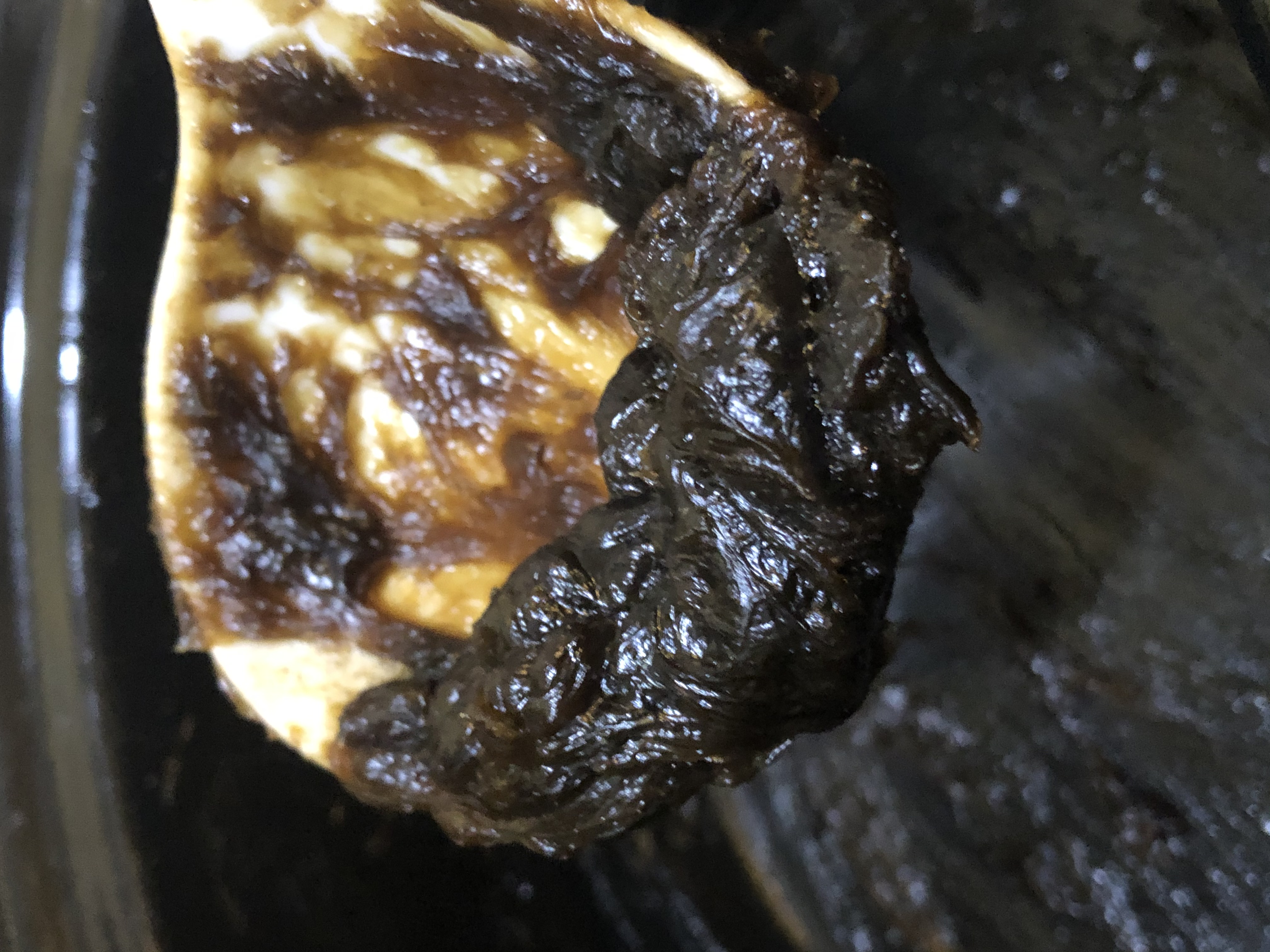
Pine Tar soap paste
With the heat on low, check the mixture every 20-30 minutes for several hours. Over that time, the mixture will start to darken in color and look like a thick gel paste. My mixture cooked for just under 5 hours (but yours could be shorter or longer depending).
When your soap turns to a thick paste that is somewhat glossy, then take out a tiny bit on a spoon and let it cool. Then mix with a bit of distilled water to dilute (it won’t completely dissolve).
Touch that diluted paste with your tongue – if it tastes like soap, then you’re done. If it zaps you.. then the mixture will has lye and needs to be cooked even further.
STEP 5: STORE OR DILUTE FOR SOAP
Now that your soap paste is done, you have a few choices. You can spoon the paste into mason jars and store in the pantry until you are ready to use it. Or.. you can dilute the entire amount and bottle it up for body wash, hand soap and even pet shampoo.
If you are diluting it, do so with distilled water.
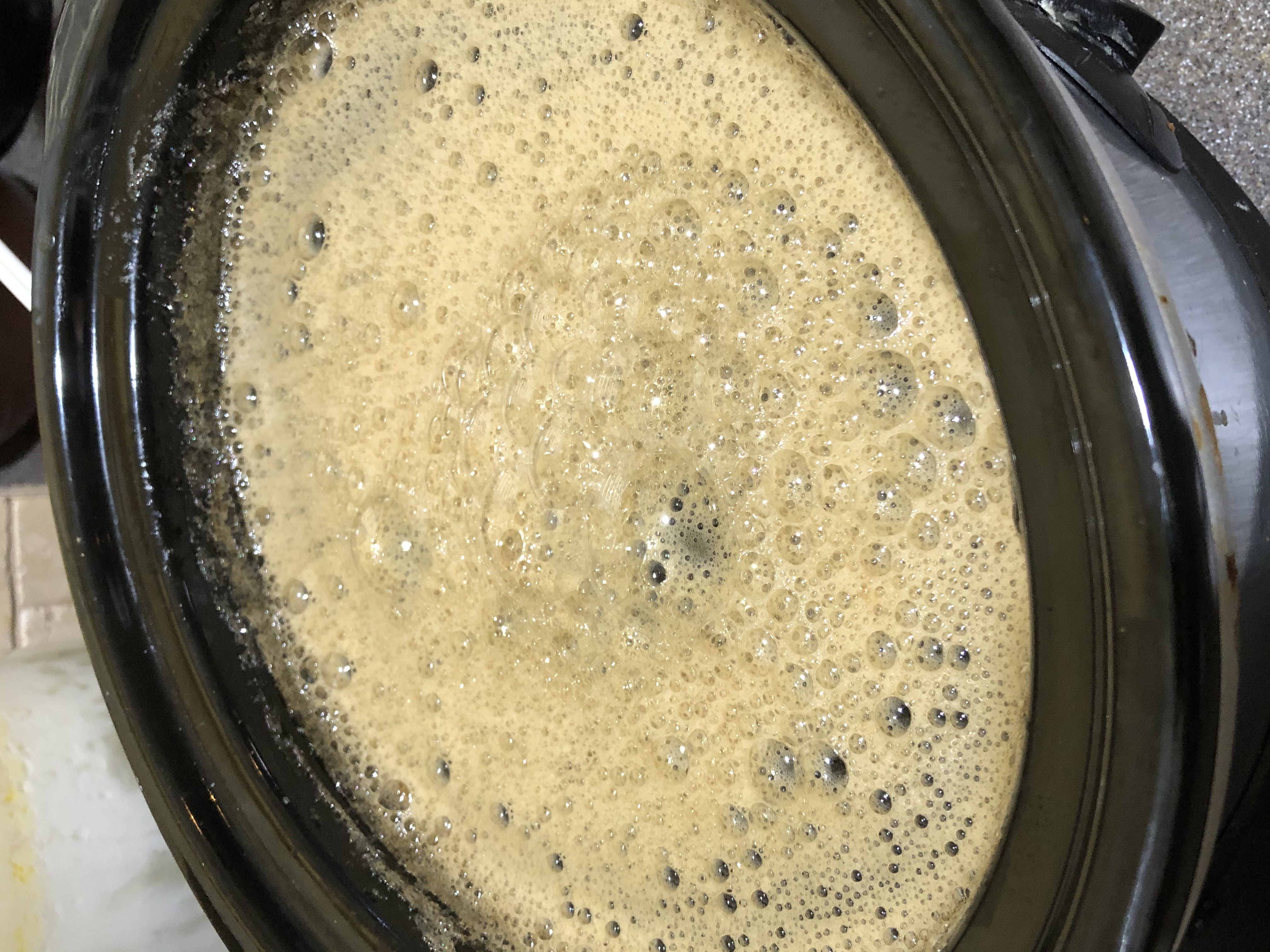
To determine the dilution for the soap paste, weigh the fully cooked soap paste on your scale. Then add equal amounts of distilled water to your slow cooker and stir in the soap paste. Place the lid on the slow cooker, and allow the mixture to sit overnight. Stir occasionally with a spoon or mash with a fork.
In the morning, the close should be dissolved (or close thereto). Mash any remaining paste with a fork and stir or. Or, use your immersion blender to quickly blend what’s left. If you take that route, you’ll have a creamy layer of bubbles on the top… just work with it. The bubbles will dissipate as time progresses and you stir with a spoon.
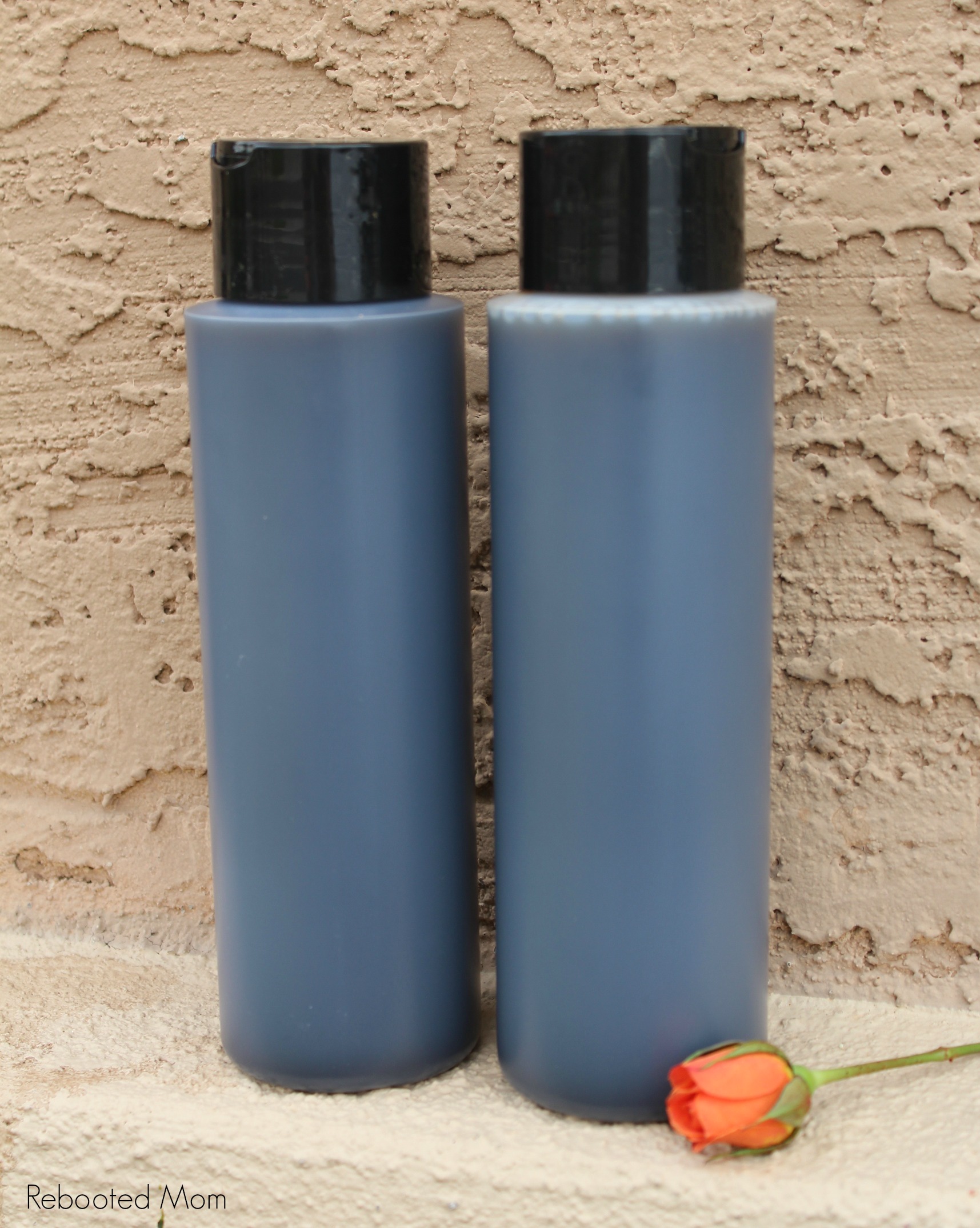
Finished liquid Pine Tar soap
Once the soap is 100% completely dissolved, it should look like like a thick, dark brown liquid. Pour through a fine mesh strainer to catch any lumps, and store in jars.
Do I have to use a preservative?
If you are selling your liquid soap, I recommend using a preservative – Optiphen can be used at 1% of the total weight of the body wash once diluted. Simply add the Optiphen to the diluted soap and give it a quick blend with the stick blender.
You may not want a preservative in this product but we can’t ignore that this product is made with distilled water and may eventually grow the nasties. If you choose not to use a preservative for personal use, keep your body wash in the refrigerator until you are ready to use. Or you can opt to use a preservative like Optiphen.
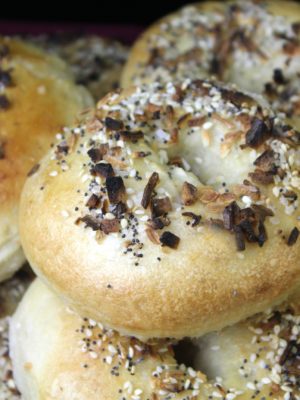
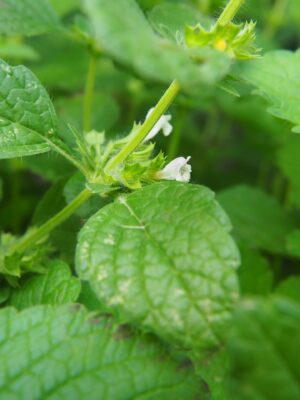
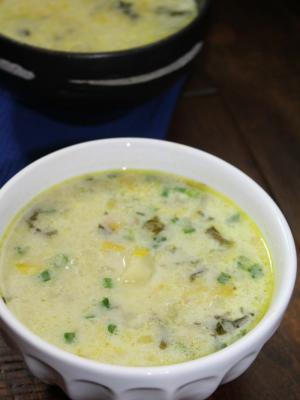
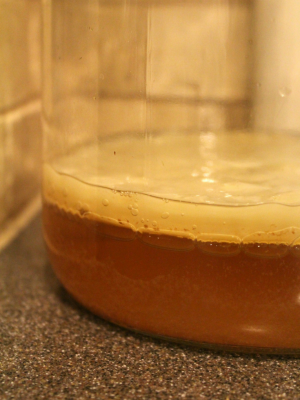
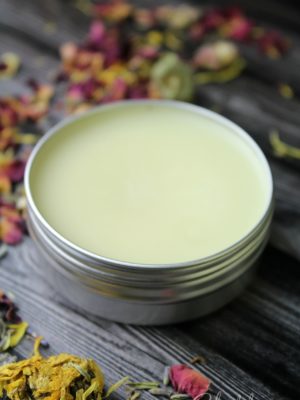
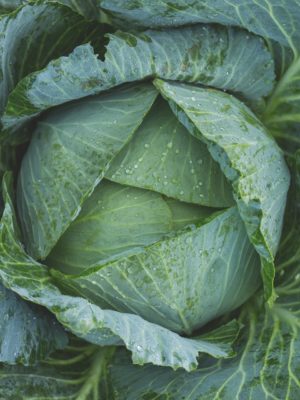

Hi and thank you so much for this! Pine tar soap is so insanely expensive for what you get but I love what it does for my skin. Thank you for this technique because you just put it in the realm of affordability for me 🙂
So welcome! Liquid soap is so much more affordable to make (I think). I make pine tar liquid soap for friends who love it and find it helpful for their skin too.
I don’t know if it’s just my system or what. Beginning at last sentence or two in step four through the end is blocked out. I cannot read it. Can you please tell me what it says. I know there’s a step 5 but I don’t know what to do.
Would it be possible for you to fix the end of this article or email me the step by step. The end of step four through the end of the article is written on top of each other
I can send it to you. I am not sure why it does that.. I have fixed it (or tried to) many times and I’m not sure what the computer throws in there to make it do that. I’ll email you! 🙂
I cannot read the last part either. I am so excited to try your recipe, my husband NEEDS this soap and will be so much easier if I can make it myself. Thank you for this info…
Brenda: I have adjusted it. Let me know if you can read it. I’m not sure what happened. I am so sorry!
for some reason it is now 24 hours and it gives me the zap taste still I followed all measurements is this normal it is thickening and looking just like your pictures I’m not yet at your end picture.
Hi Jade, did you use the same recipe I had – and if not, did you happen to make any adjustments? Sometimes, adjusting or subbing an oil will require you to re-run it through the lye calculator. I have had instances (in the past) where my scale wasn’t accurate and I used too much lye… only for it to zap me later on. Pine Tar soap usually thickens very quick and most of the time you will have the ability to remove it from the mold within 12-16 hours. Perhaps give it a little more time (another day) and then let me know how it looks so I can help troubleshoot it with you. Pine Tar is my favorite soap.
HI:
Could you send me the liquid pine tar recipe. Bottom on this page is messed up.
Thank you Very much.
Richard – I have adjusted it. Let me know if you can read it. I’m not sure what happened. I am so sorry!
Hi could you send me a copy of your liquid pine tar soap?
Not able to read the last part online.
Thanks
Hi. Your recipe sounds good, we tried it out but unfortunately it didn’t quite work out. We can’t read beyond step four of the recipe, can you please post in the comments what the last few steps of the recipe are? Thanks very much appreciate your website!
Chelsea – I have adjusted it. Let me know if you can read it. I’m not sure what happened. I am so sorry!
It must have stayed fixed this time. I’m not having a problem. My question is – is there any alternative to the taste test? I’m just really not wanting to do that. {YECH!}
I have been making soap for many years and I’ve made liquid soap, but never pine tar liquid soap so I was interested in giving it a go. I found the recipe and directions to be excellent and very clear and concise. It turned out fabulously. I replaced the distilled water with glycerin to mix with my lye but otherwise followed exactly and it turned out well. Essential oils can be added after dilution to help cover the pine tar scent but honestly, I didn’t mind it too much. Another great recipe Sheryl. Thank you!
Hello, I am at the point where I pour in the tar and blended for about a minute, but I think it is far too thick, it’s about consistency of thick mashed potatoes. It sticks to the spoon upside down without any falling off… Is this right? I weighed everything as described.
Yes – it’ll be quite thick like that (before it’s diluted!).
Once the paste is done/cooked, then you’ll want to dilute – that’s when the liquid soap thins out. If you are selling it or storing it, you’ll want to add your preservative after dilution. Good luck!
Hi there, can I replace any of these oils with lard? Like the coconut oil?
You definitely can – I would not modify the coconut oil (that encourages lather and helps with moisturizing). If you want to use lard, then I’d lower the olive oil. You’ll want to run the recipe through the lye calculator with the new oil measurements. I love using lard and tallow in my soaps (even liquid soaps) – it’s so nice to hear someone else does too 😉
I’ve actually never made soap before. This will be my first time. But I’ve had lard soap before and I loved it. I want to start making soap because I’m having a hard time finding exactly what I want in a soap. Thank you for the recipe! I’m excited to try it and get into this! Thank you for your recipe! ❤️
That’s the same reason I started making soap, too 🙂 It’s such a rewarding experience. The learning curve at first was steep (at least for me) but it has been a few years and now I’m happily making soap constantly. I love lard as well… I just made several batches this week with lard. It’s so fun to make soap with the ingredients that you want!
Could I use a cold process option for a liquid pine tar (potassium hydroxide) soap? I found one recipe for a cold process potassium hydroxide recipe but it didn’t factor in the pine tar.
https://www.instructables.com/Cold-Process-Liquid-Soap/?amp_page=true
I’m honestly not sure… I have never made a cold process liquid soap. I have only done hot process for liquid soap.
I do make cold process (hard) soap — but that’s entirely different as it uses sodium hydroxide (not potassium hydroxide). If you decide to make cold process liquid soap, you’ll want to formulate a recipe that includes pine tar and run it though a soap calculator — you can find one on SoapCalc or, Brambleberry. Pine Tar is best used in soap (liquid and hard) at a certain range of percentage so if at all possible, keep the pine tar between a certain range. Using pine tar is tricky because when you incorporate it in hard soap, it will seize up the soap batter significantly…. which is why it is probably best used in hot process — keeping it warm via crock pot is easier as pine tar will not do well if it’s at room temp. It gets hard.. like a hard glue.
You can try, certainly, but my guess is that making it cold process liquid soap will be a very big challenge for that reason. Pine Tar needs to be heated in order to have a successful liquid soap.